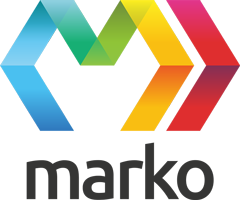Marko is a really fast and lightweight HTML-based templating engine that compiles templates to CommonJS modules and supports streaming, async rendering and custom tags. Learn more on http://markojs.com/.
You can try out Marko online: Try Marko Online!
npm install marko --saveMarko supports both a familiar HTML syntax, as well as a more concise indentation-based syntax. Both syntaxes are equally supported. Regardless of which syntax you choose, the compiled code will be exactly the same.
<!DOCTYPE html>
<html lang="en">
<head>
<title>Marko Templating Engine</title>
</head>
<body>
<h1>
Hello ${data.name}!
</h1>
<ul if(notEmpty(data.colors))>
<li for(color in data.colors)>
${color}
</li>
</ul>
<div else>
No colors!
</div>
</body>
</html>The following concise template is equivalent to the previous template:
<!DOCTYPE html>
html lang="en"
head
title - Marko Templating Engine
body
h1 - Hello ${data.name}!
ul if(notEmpty(data.colors))
li for(color in data.colors)
${color}
div else
- No colors!You can even mix and match the concise syntax with the HTML syntax within the same document. The following template is equivalent to the previous templates:
<!DOCTYPE html>
html lang="en"
head
title - Marko Templating Engine
body
<h1>
Hello ${data.name}!
</h1>
ul if(notEmpty(data.colors))
li for(color in data.colors)
${color}
div else
- No colors!var template = require('./template.marko');NOTE: On the server, you will need to install the Node.js require extension for Marko:
require('marko/node-require').install();var templateData = { name: 'Frank' };
// Render to an existing Writable stream:
template.render(templateData, process.stdout);
// Render to a callback function:
template.render(templateData, function(err, html) {
console.log(html);
});
// Render a template synchronously
console.log(template.renderSync(templateData));
// Render a template and return a new Readable stream:
template.stream(templateData).pipe(process.stdout);Marko Widgets is a minimalist library for building isomorphic/universal UI components with the help of the Marko templating engine. Marko renders the HTML for UI components, while Marko Widgets adds client-side behavior. Client-side behavior includes the following:
- Handling DOM events
- Emitting custom events
- Handling custom events emitted by other widgets
- Manipulating and updating the DOM
Marko Widgets offers advanced features like DOM-diffing, batched updates, stateful widgets, declarative event binding and efficient event delegation.
Changing a widgets state or properties will result in the DOM automatically being updated without writing extra code. Marko Widgets has adopted many of the good design principles promoted by the React team, but aims to be much lighter and often faster (especially on the server). When updating the view for a widget, Marko Widgets uses DOM diffing to make the minimum number of changes to the DOM through the use of the morphdom module.
UI components are defined using very clean JavaScript code. For example:
module.exports = require('marko-widgets').defineComponent({
/**
* The template to use as the view
*/
template: require('./template.marko'),
/**
* Return the initial state for the UI component based on
* the input properties that were provided.
*/
getInitialState: function(input) {
return {
greetingName: input.greetingName,
clickCount: 0
};
},
/**
* Return an object that is used as the template data. The
* template data should be based on the current widget state
* that is passed in as the first argument
*/
getTemplateData: function(state) {
var clickCount = state.clickCount;
var timesMessage = clickCount === 1 ? 'time' : 'times';
return {
greetingName: state.greetingName,
clickCount: clickCount,
timesMessage: timesMessage
};
},
/**
* This is the constructor for the widget. Called once when
* the widget is first added to the DOM.
*/
init: function() {
var el = this.el;
// "el" will be reference the raw HTML element that this
// widget is bound to. You can do whatever you want with it...
// el.style.color = 'red';
},
/**
* Handler method for the button "click" event. This method name
* matches the name of the `w-onClick` attribute in the template.
*/
handleButtonClick: function(event, el) {
this.setState('clickCount', this.state.clickCount + 1);
},
/**
* Expose a method to let other code change the "greeting name".
* If the value of the "greetingName" state property changes
* then the UI component will automatically rerender and the
* DOM will be updated.
*/
setGreetingName: function(newName) {
this.setState('greetingName', newName);
}
});And, here is the corresponding Marko template for the UI component:
<div class="click-count" w-bind>
Hello ${data.greetingName}!
<div>
You clicked the button ${data.clickCount} ${data.timesMessage}.
</div>
<button type="button" w-onclick="handleButtonClick">
Click Me
</button>
</div>For more details on Marko Widgets, please check out the Marko Widgets Documentation.
When marko compiles your server-side templates, a .marko.js file is created next to the original .marko file.
Subsequently, nodemon will see the new .marko.js file and trigger a restart of your app and this can
repeat indefinitely unless you configure nodemon to ignore *.marko.js files.
To avoid this, simply add "ignore": ["*.marko.js"] to the nodemon.json file at the root of your project.
As a better drop-in replacement with more features, you can install browser-refresh.
Be sure to add *.marko.js pattern to your .gitignore file and browser-refresh
will automatically ignore the compiled marko templates when they are written to disk.
See CHANGELOG.md
- Chat channel:
- Twitter: please use the
#MarkoJShashtag. Follow @MarkoDevTeam
Questions or comments can also be posted on the Marko Github issues page.
- Patrick Steele-Idem (Twitter: @psteeleidem)
- Phillip Gates-Idem (Twitter: @philidem)
- Martin Aberer (Twitter: @metaCoffee)
Pull Requests welcome. Please make sure all tests pass:
npm test
Please submit Github issues for any feature enhancements, bugs or documentation problems.
Apache License v2.0


